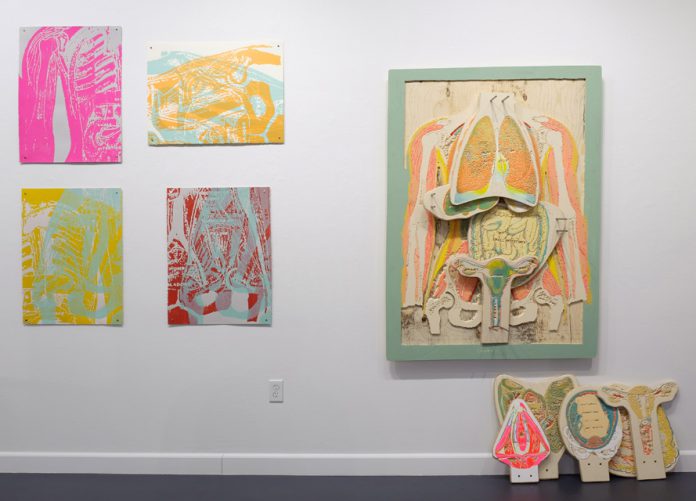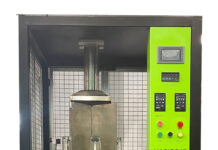Marnie Blair is a mother, an artist, a wife, a professor, a cardiac arrest survivor, and more. She is also one of the most fascinating and captivating practicing artists I’ve ever encountered.
At only nineteen years old, Blair became one of the one in one hundred people who survive cardiac arrest. Inspired by her own story, she became fascinated by the human body and began incorporating anatomy into her print making. Her own experience represents the specific and direct physical relationship that exists between Implantable Cardioverter Defibrillator (ICD) and the electrical activity of the heart.
Also an art instructor at Red Deer College in Red Deer, Canada, Blair has found herself utilizing the Techno CNC Systems LC 4896 from the college and creating one-of-a-kind art. She uses her ICD as a starting point to examine questions that surround the intersection of technology and humanity.
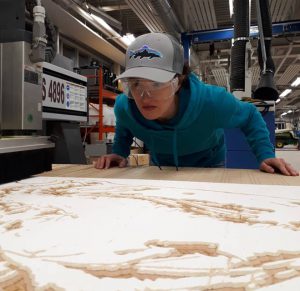
Her work explores the natural, the artificial, and what it means to be dependent on a machine in order to live. This reliance on technology references our own increasing dependence on technology and its impact on our daily life.
“I’m a print maker. I do wood cuts, etchings, and screen prints,” she says. “Across the United States, print makers do not normally have access to a CNC router, but after working at Red Deer College for almost four years, they built the Center of Innovation and Manufacturing, which then allowed for a CNC router. The president of Red Deer College gave access to all students and faculty, allowing for anybody to utilize the router in its fullest potential.
“So naturally, I brought my students to the Center of Innovation and Manufacturing to utilize the CNC router. My students and I made a four-by-eight wood cut and printed it, and the rest was history. I was so fascinated with what the router could do and how wonderful each piece was carved.”
About six months ago, Blair was fully trained on how to use the router. She spent about four months in the studio learning the software and practicing how to carve.
She began routing images inspired by the imagery in a 1900s textbook she found and bought from an antique store. Her dual purpose was to try to recreate sweat books where people can go into a gallery and flip through her art. And with the CNC router available, her vision could become a reality.
“So far, I have spent this entire summer with the router, and I love the entire process. I love carving it and then hand painting each piece afterwards,” she says.
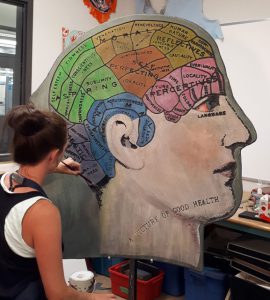
Blair programs the router based off the image from her old textbook, routes the image, hand paints the wood cut to match the colors used in the textbook, and then stamps the painted wood carving, creating a fascinating yet vintage-inspired piece of art.
“When I paint, I outline the details from the carving and make rings of paint to emphasize the carve areas,” she says.
Her work is meant to be a hybrid of old and new—woodcut is a traditional print-making process that dates back to the Han Dynasty before 220 AD, and the CNC router used to carve the imagery is a new technology.
“I am interested in how relying on a computer and machine in my artistic practice is similar to my own experience of relying on a machine, an implanted defibrillator, to ensure my body functions as it should,” she says.
Before the router, it would take Blair about a week to carve each one of her pieces. “Now I can make my art in double the time, and the carve is so much cleaner, neater, and faster,” she says. “The router adds another layer of information and aesthetic beauty to my work.”
When she first attempted to route, Blair was practicing using 3D carving techniques. Due to long cycle times, she quickly learned that these techniques were not sufficient for her project.
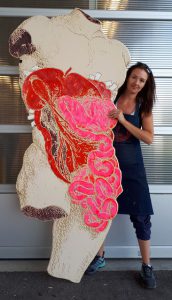
“I wanted to create a large back panel of the human body with a bunch of assembled pieces, like the lungs, the uterus, the intestines, etc., on top of it,” says Blair, “yet when I inputted the large back piece into the router; it said it was going to take hours to route.
“I absolutely loved the beautiful pattern the router created on the wood. I didn’t want to go back to carving each piece by hand. The router created this mesmerizing pattern on the wood that I would have never got if I had carved it by hand.”
After playing around with the software capabilities and learning the ins and outs of the Techno CNC router, Blair was able to reduce the file size, resulting in a reduced cycle time to complete her project. The time lowered from days and weeks, to hours and minutes.
Blair has CNC-carved a number of body parts—a shoulder, a hip bone, lungs, rib cages, a liver, intestines, a womb with a fetus, etc. “Hand-carved, this entire piece of art would have taken a year,” she says. “The back panel of the body took about a week on the router. Each organ on top takes about three hours.
“I separated the back panel into three sections since the piece requires such detail. Each piece is routed with tiny dots where the router has to come in and route each dot one-by-one. I could never do this all by hand.”
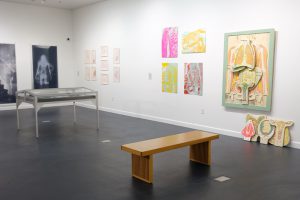
Blair’s goal is to carve every single organ she can find in her vintage medical textbook. “I love the abstract ideas that scientists had about the human body many years ago,” she says. “I am inspired by the different thought processes, the colors they used, the phenomenon about how the human brain is separated into different layers.
“I love it all, and I plan to recreate it using my knowledge and creativity paired with the CNC router.”
This work is the beginning of a larger body of work. Blair has started to carve more large pieces that will be painted—the seven layers of the brain, eyes, ears, hands, and feet, all based on medical flip charts. These pieces will be hinged like a book for viewers to flip through.
“I am so happy with where I am with my art,” says Blair. “I could not work like this without the CNC router.”
—Maryann Valentine


